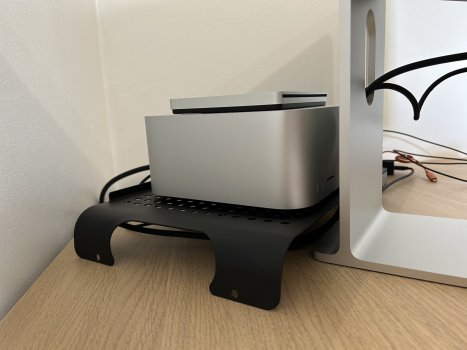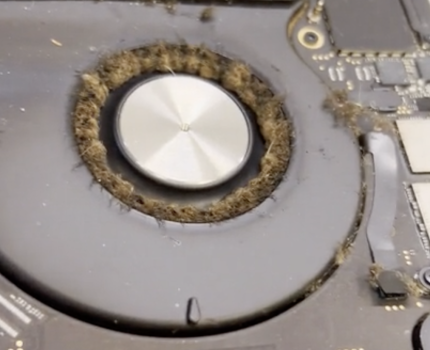Mac Studio vs. Dust
Apple Macs are electronic devices that generate heat when they operate. To prevent internal components from overheating, the overall design needs to provide sufficient airflow to carry away excess heat that can cause failure or throttling the speed of the CPU. Steve Jobs insisted that early Macs be designed without cooling fans, but as Macs evolved, there was just no way to avoid using them.
Any operating environment (outside of clean rooms) contains airborne dust particles that are drawn into the computer through the inlet screen. The inlet screen functions to prevent particles larger than the individual screen openings from entering, but smaller dust particles obviously can pass through to the interior. The air inlet area has to be large enough as to not restrict airflow, so there’s a practical limit to how small the inlet screen holes can be.
Over time, this dust builds up on the cooling fan and internal components. Dust accumulating on the fan reduces airflow volumetric efficiency and if deposited unevenly, throws the fan out of balance. This causes the computer’s internal temperature to rise and generates fan wobble noise.
Some computer operations maximize demands on the CPU and GPU causing an extreme rise in component temperatures. When this is detected, the component temperature sensors signal the fans to increase speed to generate more cooling. Dust accumulated on components reduces the heat transfer rate to the cooling air. Dust on the fans reduce the maximum cooling air delivery.
Some Macs are designed to have easy access to their internals, so periodically cleaning out dust using both vacuum and compressed air is an simple operation.
Which brings us to the Mac Studio and Mac Mini — that are not designed to be user accessible. Granted, there are web videos showing how to disassemble and clean these devices, but a better solution for most of us is to prevent dust entering entirely.
How quickly and how much dust builds up is affected by preventative measures like keeping your work area free of dust and working with your laptop on a hard table surface rather than on your lap or a couch.
Some have suggested that elevating the Mac up from your desk surface using a pedestal, or mounting it below your desk will help, but this does nothing to reduce debris from being sucked into the air intake.
Can you use vacuum or compressed air to clean these Macs thoroughly without disassembly? Not really.
The majority of internal dust is deposited on the fan vanes, so using compressed air will force most of the dust deeper into the interior (as well as some out). Vacuum will only pull dust from the interior adjacent to the air screen and won’t reach deeper than the fan into interior areas.
The proper solution is to cover the Mac air inlet with a filter material and then clean the filter when it gets dirty with a vacuum and/or compressed air. I recommend open cell foam.
Open cell foam filter material is used in motorsports and comes with different cell grades depending on air flow needs. Larger cell sizes allow more air and bigger dust particles to pass through, smaller cells are more flow restrictive but capture smaller dust particles. Note that some common packing material is open cell foam that allows air to pass through. You can check if it’s open cell foam by trying to blow air through it.
No Cost Solution
Here’s a solution using open cell foam packing material from a Mac laptop computer box. There's not an enough air flow restriction to raise the internal Mac temperatures a measurable amount. You can check internal component temperatures using the iStat Menu app.
$20 Solution
Most motorsport air filter manufacturers like UNI sell sheets of foam air filter material. Their BF-1 offers the smallest cell size — and therefore the best filtration.
https://www.amazon.com/Uni-Filter-6...ocphy=9003113&hvtargid=pla-570358928878&psc=1
I highly recommend using thicker filter material to assure a larger filtered flow area all around and from below. As the filter material collects dust, the resistance to air flow will increase causing temperatures to rise — so more filter material will extend the cleaning interval. It will also offers less flow resistance as the fans speed up to handle higher internal temperatures.
Cut to size and place the foam under the Mac Studio as a base — its weight will compress the foam enough to cover the air inlet holes if the foam is over 1/2-inch thick. Air now needs to flow though the foam to reach the Mac air inlets.
Shown are two layers of UNI Filter BF-1 material designed to protect motorsport engines.
$80 Solution
The link below is a post by a talented Croatia product designer named Gjuroo who designed an air filter cabinet that fits beneath the Mac Studio/Mini. Follow the links to purchase the 3D printer files ($20), choose your cabinet color, print the files ($40) and add the Uni filter ($20) or suggested automobile cabin filter ($10).
How to clean the Mac Studio from dust ? | MacRumors Forum
https://forums.macrumors.com/thread...rom-dust.2338827/?post=31936415#post-31936415











